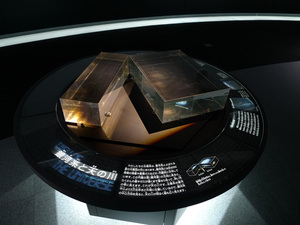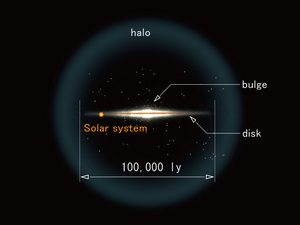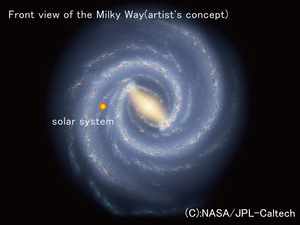Nagoya City Science Museum
TOP > Exhibition Guide > Keyword Search > Starting with "G" > galaxy > Our Galaxy and the Milky Way
Our Galaxy and the Milky Way



Purpose of Exhibition
Our solar system is part of a tremendously huge group of stars known as the Galaxy, which is composed of about 200 billion stars and interstellar gas distributed in a flat disk. Since our sun is located near the outer edge of this disk, stars are sparse in a vertical direction to the disk, while many stars pile up in the direction of the disk, which you would see a faint band of light, namely the Milky Way.
This exhibit will illustrate the relationship between the Galaxy and the Milky Way. We have made a three-dimensional model of the Galaxy with many bubbles in a large acrylic block, and then sectioned it at the point of our solar system. You can see not only the overall shape of our galaxy, but also the cross section, which would give you an image of the Milky Way.
Additional Knowledge
[How Do We Know the Shape of Our Galaxy?]
While we can see the whole picture of other galaxies, it is difficult to visualize our own galaxy because we are in it. Of course, we cannot look at our galaxy in a huge mirror. The question of how to know the shape of our galaxy is almost like the question of how to know our own shape in a world without mirrors. You cannot see your own appearance without a mirror as you cannot get your perspective away from your own body. Instead, you touch each part of yourself, or look at the faces of others around you, thinking that since we are all the same humans, we should look alike, and imagine that you might have a tall nose, or might have small eyes. It is the same with our galaxy; we can only imagine the whole picture through observing the distribution and movement of stars and comparing them with other galaxies, until we could go on a space trip outside our galaxy in the distant future.
The Galaxy is made up of a central region, the bulge, where the stars are clustered, the disk where the gas and stars are spread out, and the halo that surrounds the bulge and disk like a shell (see the figure). The bulge in our galaxy is not a sphere but a bar, with two arms extending from each end; we consider it to be a barred spiral galaxy. The disk shows a spiral pattern called spiral arms. Its diameter is about 100,000 light years, and our solar system is 28,000 light years away from the galactic center. About 150 globular clusters have been observed in the halo. It is also believed that there is a huge black hole at the center of the Galaxy.
The Galaxy rotates like a spinning disk. In the vicinity of our solar system, the velocity is about 220 kilometers per second, which means that it will take 240 million years to circle the galaxy. This is a dizzying amount of time when compared to human history, but if we compare it to the age of our solar system, we have already circled the center of the galaxy about 20 times.
This page was last edited on 30 June 2022.
Article by Astronomy Section
